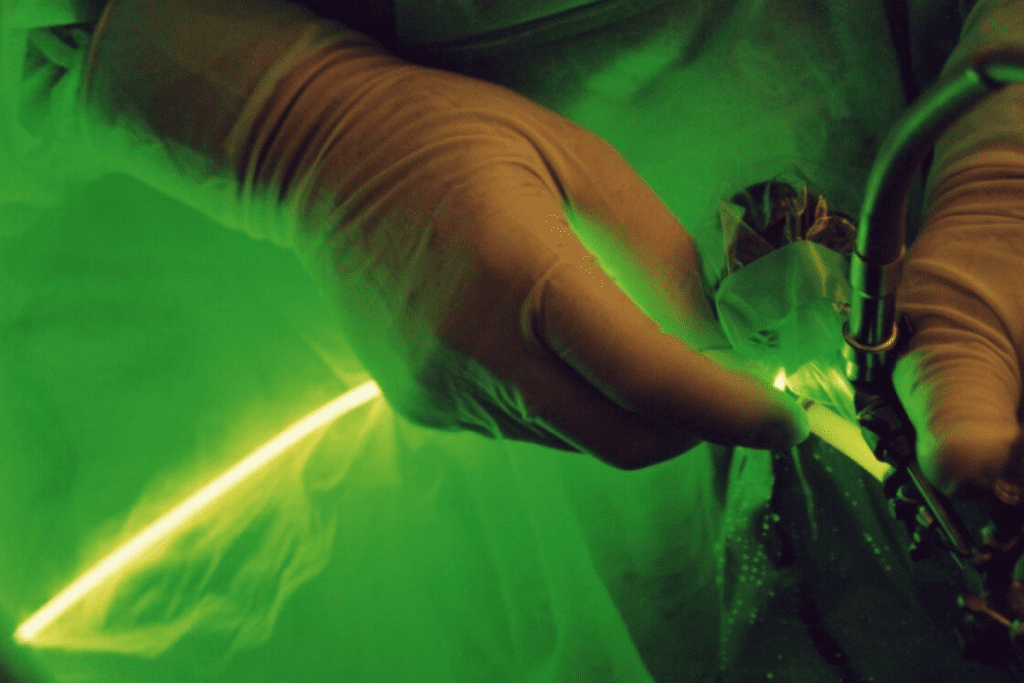Last Updated on October 31, 2025 by
PVP prostatectomy compared with HoLEP to reveal major differences in treatment and recovery.
Benign prostatic hyperplasia (BPH) is a common issue for men around the world. Two main laser treatments for BPH are HoLEP (Holmium Laser Enucleation of the Prostate) and GreenLight PVP (Photovaporization of the Prostate). Both aim to ease symptoms, but they work in different ways.
Recent studies show that HoLEP is more efficient and safer than GreenLight PVP. Knowing the differences between these treatments is key for patients looking for the best care.

As men get older, the chance of getting Benign Prostatic Hyperplasia (BPH) goes up. BPH makes the prostate gland grow too big. This can block urine flow, leading to poor bladder function.
BPH is a non-cancerous issue that affects older men. It causes weak urine flow, needing to pee a lot, and waking up to pee at night. Knowing about BPH helps find the right treatment.
Older surgery methods for BPH are invasive and take a long time to recover. New treatments like laser surgeries are better because they’re less risky and you heal faster.
Laser surgeries for the prostate, like HoLEP (Holmium Laser Enucleation of the Prostate) and GreenLight PVP (Photoselective Vaporization of the Prostate), are good for BPH. They use lasers to cut or vaporize the prostate, helping urine flow and easing symptoms.

Choosing between HoLEP and GreenLight lasers depends on the prostate size and the patient’s health. Knowing these options helps make a better choice.
PVP prostatectomy and HoLEP use special laser technologies. These methods are designed to tackle BPH challenges. They offer new, less invasive ways to treat an enlarged prostate with fewer side effects.
The GreenLight laser targets hemoglobin, vaporizing prostate tissue efficiently. This photoselective vaporization method removes blockages, improving urine flow. It’s also good for patients on blood thinners because it causes less bleeding.

HoLEP uses a holmium laser to enucleate the prostate. It’s like open surgery but less invasive. The laser cuts and removes tissue, and then it’s broken down and taken out. This method works well for bigger prostates.
PVP prostatectomy and HoLEP differ in how they work. The GreenLight laser vaporizes tissue, while HoLEP removes it. This difference affects which method is best for each patient. Knowing these details helps doctors and patients make the right choice.
In summary, PVP prostatectomy and HoLEP are leading-edge treatments for BPH. Each has its own benefits. The right choice depends on the patient’s needs, prostate size, and the surgeon’s skill.
HoLEP and GreenLight laser treatments are both good for BPH symptoms. But they work differently for each patient. The right choice depends on prostate size, symptom severity, and overall health.
HoLEP is great for any prostate size, making it perfect for larger ones. Studies show it works well even for prostates over 100 grams. GreenLight PVP is better for smaller to medium-sized prostates. It’s effective and has fewer complications.
Both treatments greatly improve symptoms and urinary flow. Patients see big improvements in lower urinary tract symptoms (LUTS). But how much improvement depends on symptoms and prostate size.
HoLEP has shown long-term success with a low reoperation rate, under 5% at 10 years. GreenLight PVP has a higher rate, about 27% at five years.
“HoLEP has a durable long-term outcome with a low reoperation rate, making it a favorable choice for many patients.” “ A Urologist
Both treatments lower Prostate-Specific Antigen (PSA) levels, showing effective prostate tissue removal. HoLEP leads to more PSA reduction because it removes the prostate. This is good for those with larger prostates or higher cancer risk.
In summary, HoLEP and GreenLight laser treatments are both effective for BPH. But their success depends on prostate size, symptom severity, and other factors. Knowing these differences helps patients make better choices.
Looking at HoLEP and GreenLight PVP, we see they differ in recovery. Both are minimally invasive for BPH, but each affects recovery differently.
HoLEP often means shorter hospital stays than old-school surgeries. GreenLight PVP is also quick, often done as an outpatient or short stay. HoLEP might have a slight edge in this area.
Catheter time is key in recovery. HoLEP needs shorter catheter times, making patients more comfortable. GreenLight PVP also has quick catheter times, making it a comfy option for patients.
Bleeding risk is a big deal for both. Both HoLEP and GreenLight PVP aim to cut down on bleeding. GreenLight PVP’s laser tech is great at lowering bleeding risks. But both have good ways to manage bleeding.
The learning curve for surgeons is important. HoLEP is more complex and needs special training. GreenLight PVP is easier to learn, making it simpler for surgeons to pick up.
When looking at surgery for Benign Prostatic Hyperplasia (BPH), it’s key to know the difference between HoLEP and GreenLight laser treatments. The American Urological Association guidelines say HoLEP is the top choice for BPH surgery. It gives full symptom relief and better urine flow, mainly for bigger prostates.
Choosing between HoLEP and GreenLight PVP depends on several things. These include prostate size, how bad the symptoms are, and what the patient prefers. GreenLight laser is good for LUTS/BPH, but HoLEP is better for bigger prostates. Talking to a doctor helps patients decide what’s best for them.
Both HoLEP and GreenLight lasers are good for treating BPH. Knowing what each does can help patients choose the best path. This way, they can get the best results for their treatment.
HoLEP and GreenLight PVP are laser treatments for BPH. HoLEP removes prostate tissue, while GreenLight PVP vaporizes it.
HoLEP is better for larger prostates. It can remove more tissue.
Both have quick recovery times. GreenLight PVP might have less catheter time and discomfort.
Both have low bleeding risks compared to old surgeries. Risks depend on the patient and the surgeon.
Both lower PSA levels are achieved by removing prostate tissue. This may reduce prostate risks.
HoLEP is harder to learn than GreenLight PVP. It needs advanced skills.
Yes, both offer long-term symptom relief. Results can vary.
Choose based on prostate size, symptoms, health, and personal preference. Talk to a healthcare professional.
Subscribe to our e-newsletter to stay informed about the latest innovations in the world of health and exclusive offers!